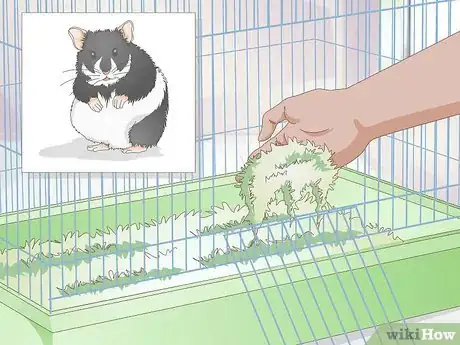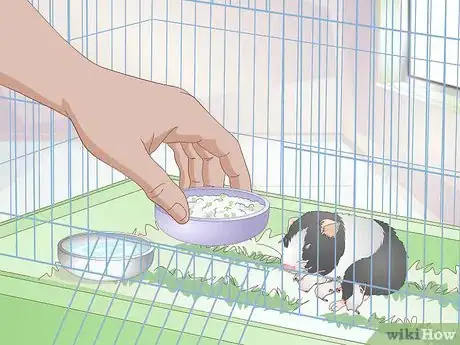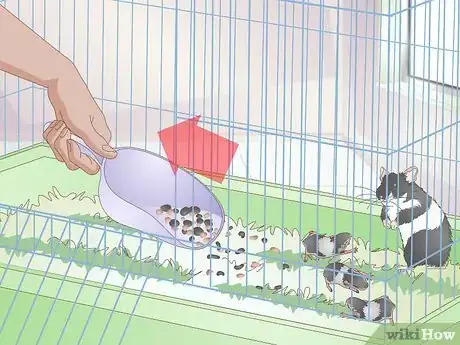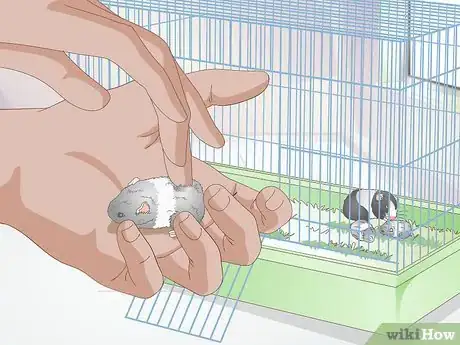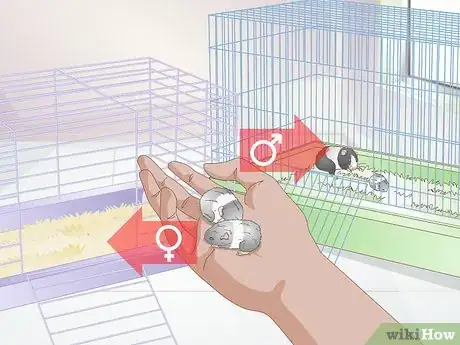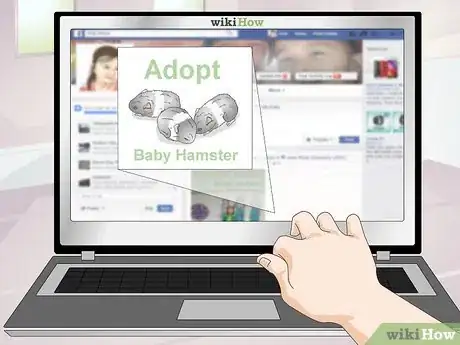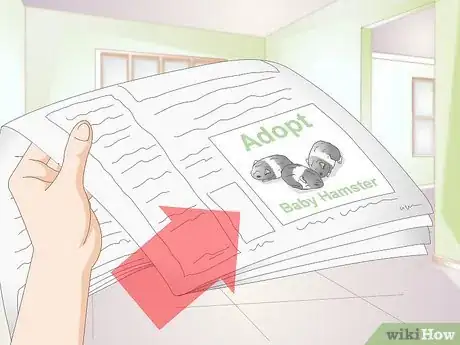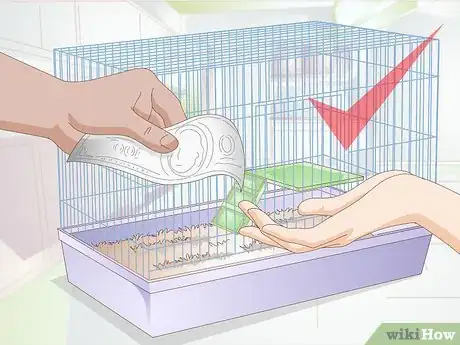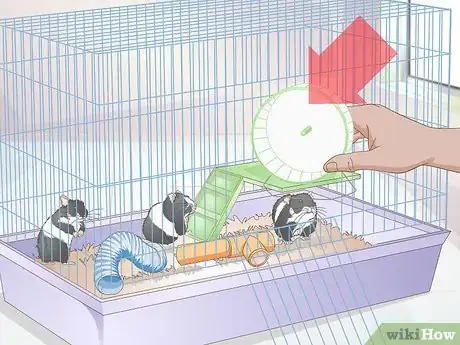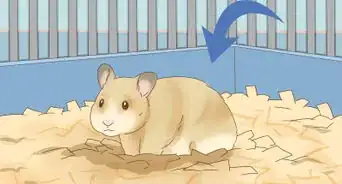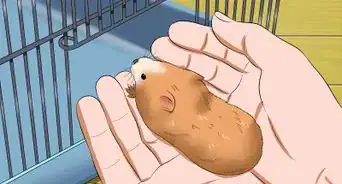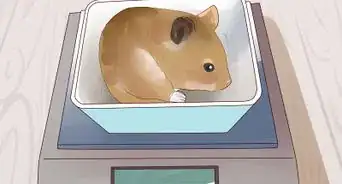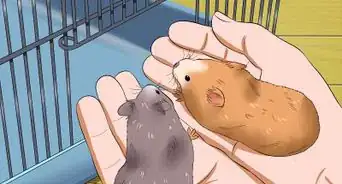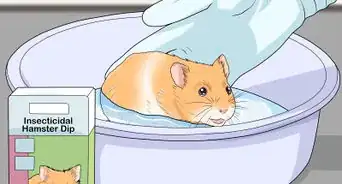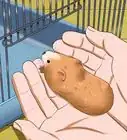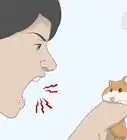This article was co-authored by Pippa Elliott, MRCVS. Dr. Elliott, BVMS, MRCVS is a veterinarian with over 30 years of experience in veterinary surgery and companion animal practice. She graduated from the University of Glasgow in 1987 with a degree in veterinary medicine and surgery. She has worked at the same animal clinic in her hometown for over 20 years.
There are 13 references cited in this article, which can be found at the bottom of the page.
wikiHow marks an article as reader-approved once it receives enough positive feedback. In this case, 83% of readers who voted found the article helpful, earning it our reader-approved status.
This article has been viewed 33,447 times.
Baby hamsters are really cute but hard work. Whether you decide to keep them or re-home them, you'll need to know how to care for them until they can leave their mother. Make sure you have the resources to keep them if you decide to. They can make great pets, if you're ready for them.
Steps
Caring for Baby Hamsters and Their Mother
-
1Talk to a vet about caring for the mother and baby hamsters. This will help to establish contact with a vet should an emergency arise with the hamster birth. You can consult about the pregnancy and options for the pups once they're born. Many vets will have experience with dealing with hamster births, but you'll want to establish the relationship before the birth so you know what experience your vet has.
-
2Prepare the cage for the baby hamsters' birth. When you know your hamster is pregnant (she will probably be more aggressive), clean her cage so that when the babies come, they have a clean cage. Also, when the babies are first born, you cannot touch the nest, so you will not be able to clean it then. Make sure to do the following to make the mother calm before and after birth:[1]
- Remove the wheel and toys. if the mother hamster uses the wheel around the babies she will injure them.
- Remove the father from the cage. If you don't, the mother hamster may become pregnant again.
- Give the mother lots of soft bedding and food. She will want to build a nest and be protective. She will also need food to recover and also feed her babies.
Advertisement -
3Do not disturb the mother hamster or babies for two weeks. This includes disturbing the cage to clean it. For a day or so leading up to the birth, you should leave the mother hamster alone. She will be stressed and protective. She will probably bite you if you try to pick her up.[2]
- You can tell the birth is imminent when the mother gets restless and becomes more active. She may also have vaginal bleeding during this time.[3]
-
4Provide plenty of food and water for the baby hamsters. Check the cage three times a day to make sure there is enough food. To avoid disturbing the mother or babies, quietly place food away from the nest of the mother.[4]
- This will mostly be the normal food the hamster already eats (mixed grains and fresh vegetables), but eggs are especially good for pregnant hamsters.
-
5Clean the cage when the babies are older than two weeks. The mother hamster will be less protective so the cage can be cleaned. You'll want to watch the mother hamster's reactions to your cleaning, and if she puts up a fuss at this stage, you may want to wait another few days.
-
6Start to handle babies when they turn two weeks old. Handling babies at this young age will help them get used to being picked up, but be careful as they are fast. This is especially necessary if you intend to re-home them. Be gentle with them, as they are still very small at this point.
-
7Separate the baby hamsters by sex at around 21-28 days old. To check the hamsters' sexes for Syrian hamsters, you simply check to see if they have testicles (as Syrian hamsters' testicles are rather large). For dwarf hamsters, you need to judge the distance between the anus and the sex organ hole. For female dwarf hamsters, the distance is much shorter. Keep the following breed-specific tips in mind when separating the hamsters.
- At five weeks old, Syrian hamsters should each be put in their own separate cages.
- Dwarf hamsters can live in gender groups. If there are fights as they grow up, separate them.
Re-homing the Hamsters
-
1Surrender your pet at the local Humane Society. There might be a fee to surrender your pet, but it can help smooth the process, and you know the hamsters will be in good hands. You should wait until the baby hamsters are at least 4 weeks old before surrendering them.
-
2Use social media to place your pets. Make sure you include photos, and tag any people you think would be interested in adopting one of your hamsters. For best results, make sure you post about it when Facebook or Twitter have higher traffic. You wouldn't want to post about your hamsters at 4am. By the time most people get up, the post will likely be buried under tons of other posts about babies, pets, and recent news.[5]
-
3Post an ad. You do this online or through your local newspaper. For some sites, it will be free, but for others you may have to pay a small fee. To find a good home for your hamsters, be descriptive in your ad and include pictures. People will likely be more interested with pictures.[6]
-
4Evaluate the potential owners. To do this, ask them questions about their ability to care for the pet. Do they seem to know about hamster care? Do they want the hamster as a pet, or do they intend to breed them? Do they have the necessary supplies (cage, food, toys, etc.)? You need to consider their ability, willingness, and knowledge to ascertain whether they will provide a good home for the baby hamsters.[7] [8]
Keeping the Hamsters
-
1Care for your hamsters as you would any other adult hamster. At five weeks old, your baby hamsters have grown up into adult hamsters. Play with, feed, and love them as you would any adult hamster.[9]
- Hamster food is not too expensive (around $.50/lb), but remember you'll be increasing the amount of food substantially. You may be able to save by buying in bulk.
- Remember that keeping just one hamster can be time-consuming. Now imagine multiplying that by 6 or more hamsters. If you have a large family, most of whom are interested in the hamsters, you may find it perfectly feasible to keep all the new hamsters. However, if you're single or very busy, and struggle to take care of just the one hamster, this might not be the best option for you.[10]
-
2Invest in cages for your hamsters. You'll need all the normal accessories, including a hiding place, a water bowl, etc. Don't forget bedding materials. You'll want your new hamsters to have the same quality of life as their mother. The typical hamster litter is 4 to 6 pups.[11] Depending on the type of hamster, this means you could need anywhere from 2 to 6 new cages. Syrian hamsters require separate cages (they can't be caged together). Dwarf hamsters can be caged in gender groups (you may need more cages if members of a particular gender group don't get along.[12] [13]
- As spaying or neutering is only recommended in the case of a health issue with the hamster, separation by gender is the far easier and cost-effective measure for keeping hamsters from reproducing.
- As a hamster cage can cost anywhere from $15 to hundreds of dollars, this can be a costly enterprise. Plan on spending at least $30 to $90 on cages alone for the new pups.[14]
- Hamster bedding can cost around $5/cubic foot. The amount you need will vary widely based on how many hamsters are housed together and how large the cage is, but the costs can add up quick.
-
3Get new toys for the new hamsters. Again you'll want to include new toys for the new hamsters. This could include tunnels, a running wheel, and chew toys. Don't forget to get toys for each new baby hamster. Hamsters need stimulation to be happy.[15]
Warnings
- This information is not intended to replace the advice of a qualified veterinarian.⧼thumbs_response⧽
References
- ↑ https://www.cuteness.com/article/stop-hamster-eating-her-babies
- ↑ https://www.cuteness.com/article/stop-hamster-eating-her-babies
- ↑ http://www.merckvetmanual.com/pethealth/exotic_pets/hamsters/breeding_and_reproduction_of_hamsters.html
- ↑ https://www.cuteness.com/article/stop-hamster-eating-her-babies
- ↑ http://bestfriends.org/resources/rehome-my-dog-cat-or-other-pet
- ↑ https://worstclpetads.wordpress.com/how-to-safely-rehome-a-pet-through-craigslist/
- ↑ https://www.petfinder.com/pet-care/giving-up-your-pet/tips-finding-home-pet/
- ↑ http://animalrightscoalition.com/doc/hamster_factsheet.pdf
- ↑ http://pets.petsmart.com/guides/hamsters/caring-for-your-hamster.shtml
- ↑ http://www.petscorner.co.uk/petopedia/syrian-hamsters/
- ↑ https://pethamstercare.com/breeding-babies/
- ↑ http://russiandwarfhamsters.tripod.com/hams/id33.html
- ↑ http://pets.petsmart.com/guides/hamsters/caring-for-your-hamster.shtml
- ↑ https://www.petco.com/shop/en/petcostore/category/small-animal/small-animal-cages-habitats
- ↑ http://pets.petsmart.com/guides/hamsters/caring-for-your-hamster.shtml
- ↑ http://www.petco.com/shop/SearchDisplay?categoryId=&storeId=10151&catalogId=10051&langId=-1&sType=SimpleSearch&resultCatEntryType=2&showResultsPage=true&searchSource=Q&pageView=&beginIndex=0&pageSize=24&fromPageValue=search&searchTerm=hamster+chew+toy
- ↑ https://www.petco.com/shop/SearchDisplay?searchTermScope=&searchType=12&filterTerm=&maxPrice=&top_category=&showResultsPage=true&langId=-1&beginIndex=0&advancedSearch=&sType=SimpleSearch&metaData=&pageSize=24&manufacturer=&resultCatEntryType=2&catalogId=10051&pageView=grid&searchTerm=hamster+wheel&minPrice=&urlLangId=-1&categoryId=10006&storeId=10151

